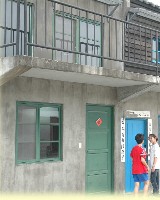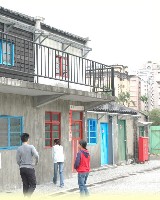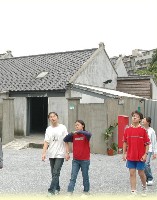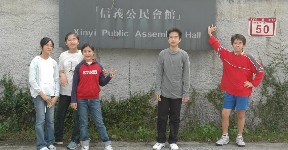 |
 |
 |
 |
| |
| Entering the showroom of military dependents' village, it's like walking in the time tunnel back to the Si-Si Nan Cun in the history. Let's experience the memory of military dependents' villagers and traces of history. |
|
|
| |
Profiles
|
|
Address
¡G |
No. 50, Sungchin Rd. , Hsinyi District, Taipei |
|
Tel
¡G |
02- 27237937 |
| Opening
¡G |
9:00 ~ 16:00 , Tuesday to Sunday, free admission |
|
 |
|
| |
|
In the beginning of October, we visited the first museum of military dependents' village in Taiwan at Hsinchu¡XHsinchu Museum of Military Dependents' Village. Taipei , where most military dependents' villages are located, has contributed great efforts in military dependents' village conservation. Part of Si-Si Nan Cun, the first military dependents' village in Taipei , was designed as historical building. |
Background ¡G |
Along with the land development of Hsinyi Planning District and reconstruction of military dependents' village, all residents of Si-Si Nan Cun was moved out in 1999, and the remaining buildings would be torn down as a result. In light of this, communities and culturati initiated the culture conservation movement of military dependents' village, and established the culture and history taskforce of Si-Si Nan Cun. After on-site review by the Historical Monuments Review Committee of Cultural Affairs Bureau, Si-Si Nan Cun was officially entitled as ¡§historical building¡¨ and four symmetric buildings were conserved for better planning. Finally, Xinyi Public Assembly Hall and Cultural Park was presented in a brand-new look with the base area of 4150 ping and building floors area about 720 ping, including special exhibition hall, showroom of military dependents' village, exhibition & performance hall, community hall, Si-Si square, and cultural park.
|
History ¡G |
In the end of November 1948, the civil war between government and communism was in an urgent state, troop Si-Si and its military depenents in Chingdau China rushed to Keelong by the Taikang Ferry, and then moved to the military site of troop Si-Si during Japanese domination for ¡§temporary stay¡¨. |
|
In the beginning, employees of military site and their dependents saw Si-Si site as their home with the hope to go back China after one year and half. They used curtains to separate households and started to build Si-Si Nan Cun. With more population, Si-Si Dong Cun and Si-Si Shi Cun were added, and three villages were completed in 1951. Nan Cun was also home of these military employees and dependents for fifty years. |
Space Design and Structure ¡G |
|
The space design of Si-Si Nan Cun was derived from the tradition of military dependents' village and its group control model, with ¡§fish bone like¡¨ structure. The main building structure and materials were bamboo slips and lime mud, and then transformed to brick structure. |
In its early stage, Si-Si Nan Cun was categorized into A, B, C building blocks, A building block was located in the west side of Chuangjing Road, B building block was located in the east side of Chuangjing Road, C was right close to the east side of B building block and nearby Hsinyi Elementary School. |
| Exhibition Hall Info ¡G |
| |
|
| Special exhibition hall |
¡G |
offers individuals, groups, or organizations with arts and cultural exhibit, including work presentation, individual work exhibit, result exhibit, and graduation exhibit, etc. |
| Showroom of military dependents' village |
¡G |
mainly for the static exhibition of Si-Si Nan Cun's cultural conservation. Topics of exhibition include Si-Si Nan Cun history traces, arts and cultures of military dependents' village, mothers at the villages, delicacies of villages, playing around the world crafts, and multimedia projection room, etc. |
| Exhibition & performance hall |
¡G |
administration affairs of Hsinyi District, exhibition of district history, local culture features introduction, and VIP room for district chief to receive important guests introducing Hsinyi district. |
| Community hall |
¡G |
provides the community with meeting room, movie watching, group room for rehearsal, performance, and courses. |
| |
|
| |
| Source¡Gthe Journal of Xinyi Public Assembly Hall, Xinyi District Office in Taipei |
|
 |
|



